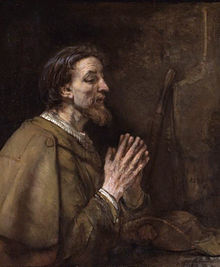St James the Apostle and St Christopher

James was the brother of John the Evangelist. He is sometimes called James the Greater, to distinguish him from James the Lesser, who may have been shorter in stature. James and his brother John were called by Jesus as they worked with their father in a fishing boat on the Sea of Galilee. Jesus had already called another pair of brothers from a similar occupation: Peter and Andrew. "He walked along a little farther and saw James, the son of Zebedee, and his brother John. They too were in a boat mending their nets. Then he called them. So they left their father Zebedee in the boat along with the hired men and followed him" (Mark 1:19-20).
James was one of the three who witnessing the Transfiguration, the raising to life of the daughter of Jairus and the agony in Gethsemane.
Two incidents in the Gospels describe the temperament of this man and his brother. St Matthew tells that their mother came (Mark says it was the brothers themselves) to ask that they have the seats of honour (one on the right, one on the left of Jesus) in the kingdom. "Jesus said in reply, 'You do not know what you are asking. Can you drink the cup that I am going to drink?' They said to him, 'We can'" (Matthew 20:22). Jesus then told them they would indeed drink the cup and share his baptism of pain and death, but that sitting at his right hand or left was not his to give - "is for those for whom it has been prepared by my Father" (Matthew 20:23b).
It remained to be seen how long it would take to realize the implications of their confident "We can!"
The other disciples became indignant at the ambition of James and John. Then Jesus taught them all the lesson of humble service: The purpose of authority is to serve. They are not to impose their will on others, or lord it over them. This is the position of Jesus himself. He was the servant of all; the service imposed on him was the supreme sacrifice of his own life.
On another occasion, James and John gave evidence that the nickname Jesus gave them - "sons of thunder" - was an apt one. The Samaritans would not welcome Jesus because he was on his way to hated Jerusalem. "When the disciples James and John saw this they asked, 'Lord, do you want us to call down fire from heaven to consume them?' Jesus turned and rebuked them..." (Luke 9:54-55).
St James was beheaded in Judea in the year 44 CE. Some Christians believe that his disciples carried his body by sea to Padrón on the Galician coast. They then buried his body under what is now the cathedral in Santiago de Compostela.
St James' relics were discovered sometime between 791 CE and 842 CE. Santiago de Compostela then became a place of pilgrimage. Pope Leo XIII asserted that the relics of St James at Compostela were authentic in a papal bull. This papal bull was published on November 1, 1884.
Common symbols of St James include a traveler's hat and a scallop shell. The scallop shell is used to mark a network of pilgrimage routes. These routes lead to the cathedral in Santiago de Compostela from many European countries. The pilgrimage to Compostella is depicted in Martin Sheen's film, 'The Way'.
(The painting is St James the Elder by Rembrandt)
and St Christopher
Martyr, probably of the third century. Very little is known about St Christopher, but he is one of the most popular saints in the Eastern and Western churches.
According to legend he was the son of pagan parents, a man of giant stature who became a Christian and wanted to serve God. He lived alone by a ford where many travellers passed. One night he carried a child across the river and as he walked the child became so heavy he could hardly stand up. The child told him: "you have been carrying the whole world. I am Jesus Christ the king you seek." The name Christopher means 'Christbearer'.
To prove his statement the child ordered Christopher to fix his staff in the ground. The next morning it had grown into a palm-tree bearing fruit. The miracle converted many. This made the king of the region (possibly Dagnus of Samos in Lycia) very angry and he had Christopher beheaded.
There are many legends about the saint, dating back to the fifth century. The earliest known church dedicated to him was in Chalcedon around 450. The oldest known picture of him, in the monastery on the Mount Sinai dates from the time of Justinian (527-65). The Mozarabic Breviary and Missal, ascribed to St Isidore of Seville (d. 636), contains a special office in his honour.
Great veneration was shown to the saint in Venice, along the shores of the Danube, the Rhine, and other rivers where floods or ice-jams caused frequent damage. Coins with his image were cast at Würzburg, in Würtemberg, and in Bohemia.
Statues of St Christopher were placed at the entrances of churches and homes, and frequently at bridges. These statues and his pictures often bore the inscription: "Whoever shall behold the image of St Christopher shall not faint or fall on that day."
The saint, who is one of the Fourteen Holy Helpers, is patron of Baden, Brunswick, Mecklenburg, and several other cities, as well as bookbinders, gardeners and mariners. He is invoked against lightning, storms, epilepsy and pestilence. But he is best know as the patron saint of travellers.












